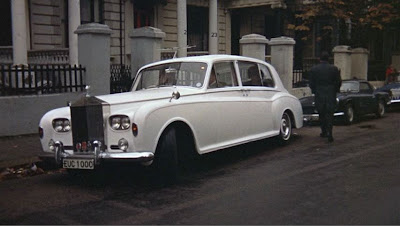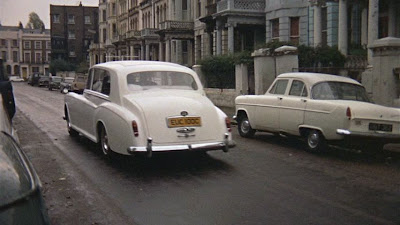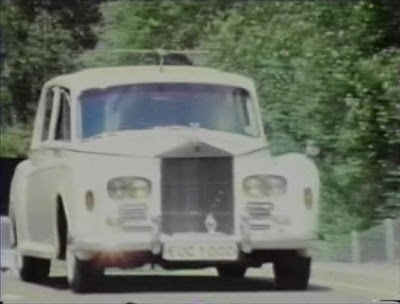A couple of years ago
I posted a blog on John Lennon’s white Rolls Royce Phantom V, the vehicle that appears at the end of Donald Cammell and Nic Roeg’s
Performance (1970), the one in which Harry Flowers sits awaiting delivery of Chas ("Hello, Chas!"). It was this white Rolls that was later used in the Apple Records promotional video, "The Ballad of John and Yoko" (1969). It so happens that three different Rollers were used in
Performance: the black one, shown in the film's opening moments; the black Rolls in the garage with a "tasty finish" on which acid is poured, destroying the paint job (actually that Rolls was coated with a clear substance that reacted to the chemicals in the liquid dumped from the jug—that wasn’t
real acid poured on the Rolls!); and the white Rolls-Royce belonging to John Lennon used in the last sequence.
I'm happy to report that my post on Lennon’s white Phantom V prompted Eric Roberts of Brisbane, Australia to conduct some original research on Lennon’s second Rolls, which he kindly shared with me. I wrote him asking permission to share his findings on this blog, and he agreed. I wish to thank Eric for both the research and for allowing me to publish the information here. If anyone has additional information, especially regarding the date of John Lennon's purchase of the white Rolls Royce (EUC 100C), please write and I'll share it here. If anyone is willing share archival images of the white Rolls, please send them to me and I'll post them. Mr. Roberts' essay follows.
JOHN LENNON’S OTHER ROLLS ROYCE by Eric Roberts
Please note:
1. I think I saw (somewhere on the web) original documentation stating that FJB 111C was originally black. I may be wrong.
2. I am no expert when it comes to the subtle differences between various models of Rolls Royce cars. Is EUC 100C a Phantom V or a Silver Cloud III?
Everyone knows that, in 1967, John Lennon’s black, 1965 Phantom V, registration FJB 111C, was repainted yellow and covered in colourful gypsy-inspired designs. While it seems fairly conclusive that the original colour was black, a number of websites insist that it was white when Lennon bought the vehicle in June 1965 and that, subsequently, he decided to respray it black. Clearly, this cannot be true, since the so-called “psychedelic” Rolls Royce has a different number plate to the white Rolls that Lennon used from 1968 until he moved with Yoko to the United States. Further research is needed to verify that sometime ca. 1967-68, Lennon purchased a second Phantom V, identical to his 1965 black Rolls FJB 111C. It is important to recognize that Elvis Presley owned a 1960 Phantom V Roller, which he bought with the proceeds from his five picture deal with Warner Bros. Similarly, Lennon seems to have splurged on a Phantom V around the same time that The Beatles were contracted to make the movie
Help!
In the aftermath of the critical failure of
Magical Mystery Tour (1967)—in which FJB 111C makes a cameo appearance—Lennon began a new phase of his life with Yoko Ono. Lennon takes to wearing white clothes. The interiors of their new home, Tittenhurst, are predominantly white, and the exterior is (strikingly) white. White seems to take on a symbolic significance for both John and Yoko. Presumably, his psychedelic Rolls Royce was no longer an expression of who he was. It could only associate him with The Beatles in the mind of the media and the fans.
EUC 100C looks identical to FJB 111C, apart from the paint work and the wing-like radio antennae mounted on the roof. In the mid-1960s, the Phantom V was longer and heavier than the Silver Cloud III – a flying fortress, fully equipped with the latest communications technology. It was a status symbol and a mobile office within which one could feel perfectly safe. So taken was he with the new Roller that he took Yoko on an extended driving tour through Europe. Yoko is quoted as saying:
“He [John] had this beautiful white Rolls Royce and he said to me: ‘We should go round Europe in this car.’ I said Great! Let’s do that!”
Because of the matching number plates, we know that this was the same vehicle that was used in the film
Performance shot in London in 1968. EUC 100C was also used in several Beatles photo shoots. Film and photographs from the late 1960s of John and Yoko contain glimpses of the white Phantom V, whereas FJB 111C would seem to have been put into semi-storage in Lennon’s garage at Tittenhurst.
THE SPECTOR CONNECTION
As the Beatles were in the final stages of disintegration as a band, John Lennon and Yoko Ono’s global Peace campaign took them to Montreal and Toronto , where Lennon agreed to take part in a rock festival featuring some of his idols, such as Jerry Lee Lewis and Little Richard. Having missed Woodstock, Lennon felt the need to honour this post-bed-in commitment, the only snag being that he had no band. By chance, he saw a young drummer playing in a London club and immediately recruited him into the newly formed Plastic Ono Band. Alan White, then 20 years old, only learned that Eric Clapton was also in the band at the airport. White went on to play on the
Imagine album, recorded in Tittenhurst Manor and produced by Phil Spector. According to Alan White, at the end of the final session, Lennon was so ecstatic with Spector’s work that he gave him the white Phantom V:
“I’m giving you my white Rolls-Royce outside. That is what he said; he said, you’ve done a great job, I’m giving you my Rolls-Royce. And he gave him his white Rolls-Royce – the huge one that he used, and he gave it to him that day. He said take it, see you’ve done a good job… Amazing.”
Strangely enough, housed in Phil Spector’s garage in Los Angeles, is a white Rolls Royce that looks very like EUC 100C. (The original number plates have been changed to PHIL 500).
Telegraph journalist, Mick Brown, in his book and various articles on his meeting with Spector a few months prior to Lana Clarkson’s murder, insists that Spector’s white Rolls is a Silver Cloud III, and gives its year of production as 1964 or 1965, depending on which of his articles you read. How certain is Brown that it is not a Phantom V?
To the untrained eye, a white 1965 Silver Cloud III would be very difficult to distinguish from a white 1965 Phantom V. Spector kept everything Lennon gave him—drawings, guitars, etc.—so why wouldn’t he keep Lennon’s classic Roller?
The only problem is that, in Longmont Colorado, multi-millionaire named Stephen Tebo, claims to have John Lennon’s white Rolls Royce in his private Tebo Auto Collection. In all probability, then, EUC 100C is owned either by Tebo or Spector. But which is it? How can we find out for sure and put this mystery of Lennon’s white Rolls Royce to bed?
REFERENCES:
1) Phil Spector: Nobody Would Want His Life Now
Telegraph
Mick Brown
14 Apr 2009
Our meeting was, to say the least bizarre. A 1965 Rolls Royce ferried me from my Los Angeles hotel to the Pyrenees Castle, driven by the same chauffeur who would later testify in court that he had seen Spector emerge from the mansion on the night of February 3 holding a revolver in his bloodied hand, and say, “I think I killed somebody.”
Link:
http://www.telegraph.co.uk/news/newstopics/celebritynews/phil-spector/5154302/Phil-Spector-nobody-would-want-his-life-now.html
2) Notes From the Edge #247
Mike Tiano
August 11, 2001
Mike Tiano: So, along with working with John Lennon, you also worked with Phil Spector on a lot of (the Imagine) sessions. Any memories or stories that pop into your mind?
Alan White: Just small things like John walking up to him [and] in front of me, saying [to Spector], “I’m giving you my white Rolls-Royce outside.” (laughs). That is what he said; he said, you’ve done a great job, I’m giving you my Rolls-Royce.
MT: He said that to Phil?
AW: Yeah, and he gave him his white Rolls-Royce—the huge one that he used, and he gave it to him that day. He said take it, see you’ve done a good job... amazing.
Link:
http://nfte.org/interviews/AW247.html
3) Pop’s Lost Genius
Mick Brown
4 Feb 2003
A car was waiting for me downstairs, a white 1964 Rolls-Royce Silver Cloud, license plate ‘Phil 500’.
Link:
http://www.telegraph.co.uk/culture/music/rockandjazzmusic/3589445/Pops-lost-genius.html
4) Tearing Down the Wall of Sound by Mick Brown (Knopf, 2007)
A car, I was informed, would be collecting me from my hotel at noon. At the appointed hour, a white 1965 Rolls-Royce Silver Cloud, license plate PHIL 500, drew up outside the hotel.
5) With a Bullet
Joe Domanick
Los Angeles Magazine, April 2007
Phil Spector’s arrest came at the end of a long, traumatic night. It began when his backup chauffeur, Adriano DeSouza, drove his red Ford Crown Victoria up the castle’s steep, winding quarter-mile-long asphalt driveway and parked adjacent to the two-story, six-car garage and motor court. A Brazilian army veteran working illegally in L.A. while on a student visa, DeSouza - who was formally dressed in a chauffeur¹s uniform of black suit and tie and white dress shirt - locked his car, walked past Spector’s 1964 white Rolls-Royce Silver Cloud to a shiny new black Mercedes-Benz S430. He got behind the wheel and waited until Spector stepped out of the rear door at about 7 p.m.
Link:
http://www.lamag.com/article.aspx?id=14736
6) Mrs. Phil Spector’s Hot Rides
Rachelle shows 20/20 her husband's 1965 white Rolls Royce Silver Cloud.
Video - 00:21 | 07/30/2009
Link:
http://abcnews.go.com/video/playerIndex?id=8213055
7) Yoko Caused International Incident With Belgium Strip Show
The Quietus, Ben Hewitt, September 10th, 2009
She also revealed that she had been forced to keep a low profile when she returned to Belgium with John Lennon, adding: “He [John] had this beautiful white Rolls Royce and he said to me, ‘We should go round Europe in this car.’ I said ‘Great! Let’s do that!’ So we were driving round Europe until he said: ‘Now we’re going to go to Belgium’. I said, ‘John, er, I have to tell you something!’
“And he said, ‘Oh, well, let’s just lie low.’ So we were lying down very low in the back of the car. We drove through Belgium on the floor of the car! But they didn’t stop us!”
Link:
http://thequietus.com/articles/02706-news-yoko-ono-caused-international-incident-after-stripping-in-belgium
8) Tebo Auto Collection
Longmont Colorado
Jump on this unique opportunity to attend a private event featuring Stephen Tebo’s extensive collection of antique and classic motor vehicles. Mr. Tebo started his car collection in 1975 when he purchased a sleeve-valve, three-door 1925 Willys Knight for $2,500. Recent additions include a 1929 Duesenberg and a mid-1960s Shelby Mustang. Other highlights are John Lennon’s white Rolls Royce, Steve McQueen’s Indian Chief, Frank Sinatra’s Jeep, the taxi used on the Jerry Seinfeld show, a limited-production 1954 Kaiser Darrin, a room of Corvettes, a room of British cars, vintage fire trucks and much, much more. This rarely-seen private collection will go back under wraps after this event, so don't miss your chance!
Eric Roberts
Brisbane, Australia





















